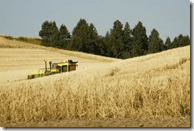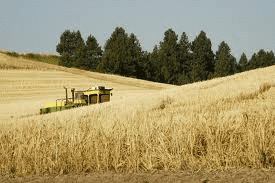 Wheat farmers might be the only people in Washington not complaining about the state’s recent run of cool, wet weather.
Wheat farmers might be the only people in Washington not complaining about the state’s recent run of cool, wet weather.
It’s giving them a late but bountiful harvest, and helping balance the paltry crops coming out of the country’s drought-ravaged Plains states.
Washington is expected to leapfrog over Texas and Oklahoma in winter-wheat production this year, making it second only to Kansas, where production is down 24 percent.
"It’s kind of rare that we’d be No. 2," said Bob Hoff at the farm-news network Northwest Ag Infonet in Spokane.
"The cool, wet spring helped boost our yields, which is the opposite of what happened in Texas, Oklahoma and Kansas, where they had a severe drought," he said.
The U.S. Department of Agriculture expects Washington’s winter-wheat yields to be 72 bushels an acre, just one bushel short of the state record from 2000.
Prices are strong, too, because investors have flocked to commodities markets as an alternative to stocks.
Soft white wheat, which represents 78 percent of Washington’s wheat acreage, is used for doughnuts, cookies and crackers and fetches relatively low prices compared with other types of wheat.
But Washington is lucky this year that it leans on soft white wheat, because other types, like those used in bread, are discounted if they do not have high levels of protein. That has happened to some farmers this year whose crops have not had the hot, dry weather that helps create higher protein.
The price for soft white wheat in Portland, where exporters ship much of it to Asia, is hovering around $6.75 a bushel, about 30 cents higher than it was a year ago.
"Coupled with our high yield, it makes a very valuable crop for us this year," said Stephen Guy, an extension agronomist at Washington State University.
The state also does not rely heavily on wheat planted in the spring, like other northern states do. Spring wheat has a shorter growing season than winter wheat, which is planted in the fall and harvested the next year.
Spring wheat has suffered this year.
"In some high-rainfall areas, the spring wheat did not get planted, because it was so difficult to get into the field," Guy said.
Too much spring rain created bigger problems in Idaho, Montana and North Dakota that it did in Washington.
Randy Suess, a third-generation farmer in Colfax, Whitman County, said he’s not sure how his spring wheat will fare.
"We haven’t cut it yet, because it’s still green," said Suess in a telephone interview from a combine. He is harvesting winter wheat, which is coming in at about 100 bushels an acre, about 10 bushels more than usual.
Even with good prices, he said, fuel, fertilizer and seed costs have risen so high that no one will get rich.
"If it’s $7 a bushel, that’s good. If it goes down to $5, a lot of farmers will be looking for another job," Suess said.
The winter-wheat harvest is running late this year because of the rain and cool temperatures.
Some farmers are harvesting in one field and planting next year’s wheat in adjacent fields, said Scott Yates, director of communications for the Washington Grain Commission.
"Drier areas are getting a phenomenal harvest," he said. In some cases, areas that usually see 35 bushels an acre are harvesting 70 bushels.
Wheat is Washington’s fourth-largest agricultural commodity, after apples, milk and potatoes.
Nearly all of Washington’s wheat — 85 to 90 percent — ends up in foreign countries, mostly in Asia, according to the Washington Grain Commission. Japan is the state’s biggest wheat customer.
Wheat farmers here rarely see crop failures, unlike those in drought-prone states, Yates said.
"We are so lucky that our weather is so consistent," he said. "Even when it’s really dry, these guys eke out a harvest."
That’s largely because of Washington’s relatively temperate weather, but also because it has many microclimates with a range of rainfall patterns. If one microclimate does poorly, another will make up for it, Yates said.
"We’ve never run into a situation, knock wood, like Oklahoma or Texas, where the weather is just bad all over," he said.
Farmers are starting to plant winter wheat for next year and need enough moisture in the soil for proper planting and germination. Those in the Plains states are worried that the continuing drought will hurt next year’s crop.
"The implications for this drought will last more than one year," said Dana Peterson, CEO of the National Association of Wheat Growers in Washington, D.C.
Although the U.S. produces only about 10 percent of the world’s wheat, it is consistently the largest wheat exporter, selling about half the crop to other countries.
Local wheat prices are increasingly affected by global supply and demand.
Last year’s prices, for example, were bolstered by droughts in Australia and the Ukraine.
Other commodities, like corn and soybeans, also affect wheat prices.
High demand for corn by ethanol producers and by consumers in other countries have helped drive up wheat prices, said Rich Koenig, chairman of the Department of Crop and Soil Sciences at Washington State University.
"These are global food commodities, so we’re seeing more impact of global food demand on local grain prices," Koenig said.
Washington is in a good position to compete globally, he said. "The climate is exceptionally well suited for producing wheat."
http://seattletimes.nwsource.com/html/businesstechnology/2016016132_wheat26.html

Deprecated: strpos(): Passing null to parameter #1 ($haystack) of type string is deprecated in /home/agriviek8Qv/agriviet.net/public_html/wp-includes/comment-template.php on line 2522